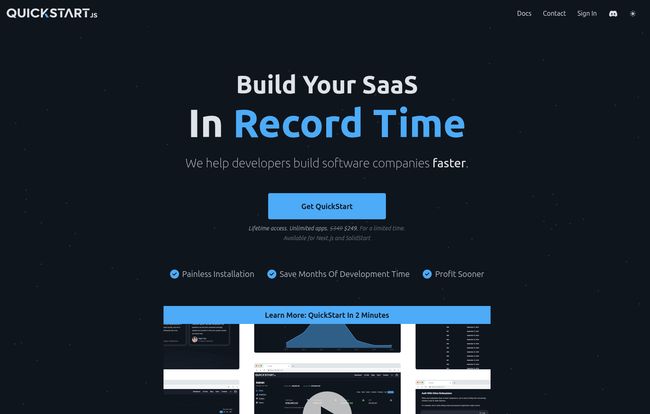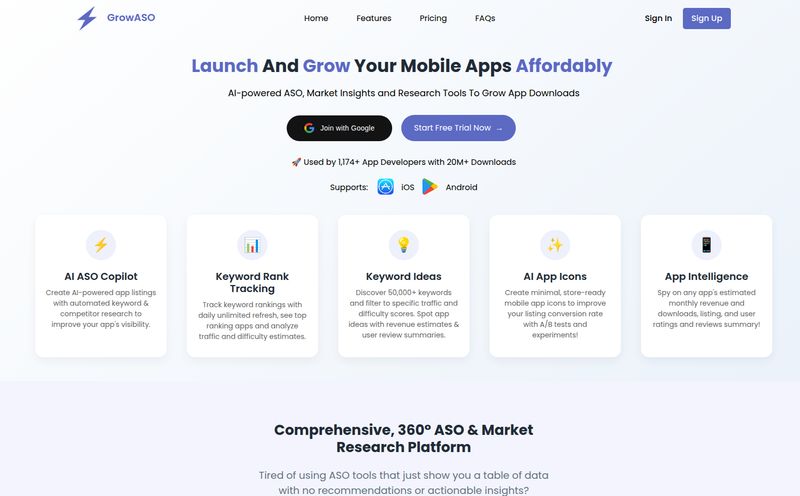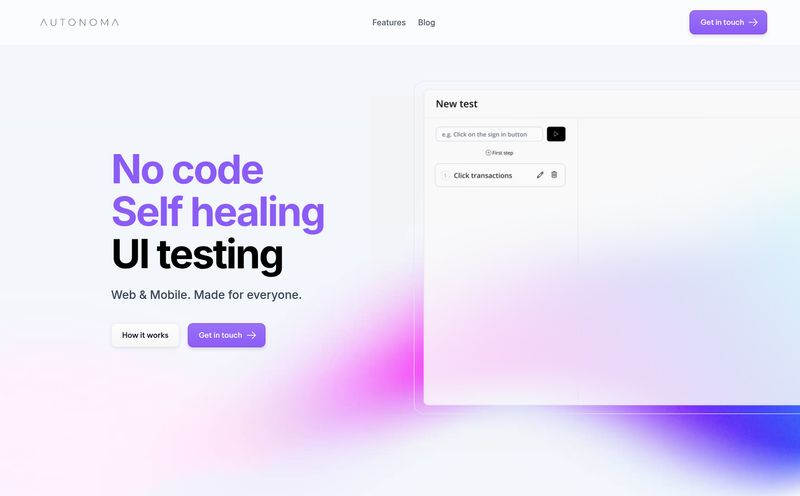You’ve got a killer SaaS idea. It’s been rattling around in your head for months, maybe even years. You can see the UI in your dreams, you know exactly the problem it solves, and you're ready to build. Then, reality hits. The mountain of setup that stands between you and your first line of feature-specific code.
Ugh. The boilerplate. User authentication, setting up subscription payments, creating a user account page, an admin dashboard… It’s the digital equivalent of digging the foundation and laying the plumbing for a house. It’s absolutely necessary, but nobody throws a party for a perfectly installed U-bend. It’s tedious, time-consuming work that has to be done before you can get to the fun part—you know, actually building the thing that makes your app special.
I've been there more times than I care to admit, staring at an empty code editor, thinking, “Do I really have to set up JWTs and password resets from scratch again?” That's where tools like QuickStart come in. They promise to hand you the keys to a house that’s already built, letting you get straight to the interior design. But is it a solid foundation or just a pretty facade? I decided to take a closer look.
So, What Exactly is This QuickStart Thing?
In simple terms, QuickStart is a premium SaaS starter kit built for developers who use Next.js or SolidStart. Think of it as a massive head start. It’s a pre-built codebase that comes with all the common, production-ready features already integrated. We’re talking about user logins, payments, account management, and even an admin dashboard, all wired up and ready to go.
The entire point is to slash your development time. Instead of spending weeks (or even months) on the boring, repetitive stuff, you can focus your energy on what makes your software unique. It’s for the indie hacker trying to launch a product on the weekend, the small agency that needs to spin up projects for clients faster, or any developer who values their time more than reinventing the wheel.

Visit QuickStart
The Never-Ending Chore of SaaS Boilerplate
Let's be honest for a second. The excitement of a new project has a half-life. It’s at 100% when you buy the domain name. It’s probably at 80% when you initialize the Git repo. By the time you’re wrestling with Stripe webhooks for the third day in a row, that excitement can drop to dangerously low levels.
This is the stage where so many great ideas die. It’s not that the idea was bad, or the developer wasn’t skilled. It's just that the initial grunt work can be so demoralizing. You have to handle:
- Authentication: Secure sign-ups, logins, password resets, social logins.
- Payments: Integrating with Stripe, handling different subscription tiers, cancellations, and the dreaded webhooks.
- User Management: A place for users to update their profile, change their password, and manage their subscription.
- Database: Setting up tables and schemas for users, subscriptions, etc.
Each one of these is a project in itself. QuickStart’s proposition is simple: what if all of that was just… done?
A Look Under the Hood: QuickStart's Core Features
Okay, so it saves time. But what do you actually get? Let’s break down the main components. It’s quite a list.
Authentication and Database with Supabase
Right out of the box, QuickStart is integrated with Supabase for both authentication and database management. If you haven't used Supabase, it's an amazing open-source alternative to Firebase. It gives you a Postgres database, authentication, and more with a fantastic developer experience. Having this set up from day one, with all the necessary database schemas for users and accounts, is a huge win. No more messing around with connection strings and auth providers. It just works.
Getting Paid with Stripe Integration
Money! The lifeblood of any SaaS. QuickStart comes with a full Stripe integration. This isn’t just a simple checkout button. It includes a pre-built Stripe webhook handler, which is critical for reliably managing subscription statuses. It's configured to handle payments and create a paywall or access management system. You can easily protect certain pages or features and require a subscription to access them. This is often one of the trickiest parts to get right, so having a production-ready solution is a massive relief.
The All-Important Admin Dashboard
An often-overlooked but critical piece of any SaaS. You need a place to see your users, manage their access, and get a high-level view of your business. QuickStart provides an admin dashboard from the get-go. It’s one of those things you don't think you need until you desperately do, and building one from scratch is always a bigger task than you anticipate.
More Than Just the Basics (AI, Blog, and More)
Moving beyond the absolute essentials, the Pro plan offers some seriously cool extras. You get a pre-built blog, which is fantastic for content marketing and SEO. There’s an OpenAI Chat Agent ready to be wired up, legal templates for your Privacy Policy and Terms of Service, and even an analytics dashboard.
The blog alone is a great feature. Building a performant, SEO-friendly blog inside a Next.js app is a project in itself. And that OpenAI agent? In 2024, not having an AI story is a missed opportunity. This gives you a launchpad for it.
Is the Price Right? A Breakdown of QuickStart's Cost
This is where the rubber meets the road. QuickStart isn’t a free open-source library; it's a premium product. It operates on a one-time payment model, which I personally find refreshing in a world of endless monthly subscriptions. Pay once, use it on as many projects as you want, forever. Here’s how the pricing stacks up (note: these are listed as limited-time offers).
| Plan | Price (One-Time) | Key Features |
|---|---|---|
| Basic | $219 | All the core boilerplate: Supabase auth & DB, Stripe payments, Admin Dashboard, Email, Themes, SEO, etc. |
| Pro | $249 | Everything in Basic + OpenAI Chat Agent, Analytics Dashboard, Blog, and Legal Templates. |
| Ultimate | $1499 | Everything in Pro. The feature list looks the same, so this tier might include premium support or services not listed. |
Honestly, the jump from Basic to Pro for just $30 seems like a no-brainer. You get the blog and the AI agent, which are huge value-adds. The real question is: is $249 worth it? If you value your time at a modest freelance rate, say $50/hour, this pays for itself if it saves you just five hours of work. And trust me, setting all this up from scratch will take you way more than five hours.
My Honest Take: The Good and The Not-So-Good
No tool is perfect, so let’s get real. Here’s what I think after digging in.
What I Really Like
The time savings are undeniable. It's not just about speed, it's about momentum. By skipping the boilerplate bog, you can stay in that high-excitement phase of your project and focus on building the features that will actually attract users. I also love the one-time fee. It feels fair and developer-friendly. You buy it, you own it, you get lifetime updates. Simple. The choice of tech—Next.js, Supabase, Stripe—is also spot on. It's a modern, powerful, and scalable stack that a lot of us are using anyway.
A Few Things to Keep in Mind
This isn't a magical “no-code” solution. You are buying a codebase. You still need to be a developer to work with it, customize it, and build on top of it. That’s not really a negative, just something to be clear about. The one-time cost, while fair, might be a hurdle for someone just starting out with zero budget. And of course, you are building on top of third-party services like Supabase and Stripe. This is standard practice for almost any modern web app, but it's a dependency to be aware of. If you wanted to use a different auth provider, you’d have some work to do to refactor the code.
Who Is QuickStart Actually For?
I see a few perfect fits for QuickStart:
- The Indie Hacker: You have a day job and you’re building your dream on nights and weekends. Your time is gold. This gets you to an MVP much, much faster.
- The Serial Entrepreneur: You're always spinning up new ideas and testing them. This allows you to test more ideas in less time, without re-doing the same setup every single time.
- The Freelancer/Agency: You need to build similar types of apps for different clients. This can become your internal starter kit, massively improving your efficiency and profitability.
If you're a beginner learning to code, it might be better to build these systems from scratch at least once to understand how they work. But once you know how, doing it over and over is just a time sink.
Frequently Asked Questions about QuickStart
Do I need to pay for Supabase and Stripe too?
Yes. QuickStart provides the code integration, but you'll still need to sign up for accounts with Supabase and Stripe. Both services have generous free tiers that are often more than enough to get your project started.
Can I customize the design?
Absolutely. You get the full Next.js/SolidStart codebase. The platform includes a theming system with 32 themes to start, but you can change anything and everything, from colors and fonts to layout and components.
What if I'm not a Next.js developer?
QuickStart provides codebases for both Next.js and SolidStart. If you don't use either of those frameworks, then this particular starter kit won't be the right fit for you.
Is the one-time payment really for lifetime use?
According to their site, yes. You pay once and get to use the code on unlimited projects forever, and you also get lifetime updates. This is a pretty significant part of its value.
So, Should You Get QuickStart?
Look, I'm always a bit skeptical of shortcuts. But in the world of software development, not all shortcuts are created equal. Some lead to a mess of technical debt. Others, like QuickStart, are more like taking a high-speed train instead of walking. You still have to know your destination and what to do when you get there, but you arrive much faster and with a lot more energy to spare.
If you're a developer who wants to build and launch SaaS products, I think the value is obvious. The cost is a tiny fraction of the development time it saves. It lets you skip the boring part and get right to the heart of your idea. And for me, that's not just a time-saver; it’s a motivation-saver. And that, right there, might be the most valuable feature of all.
Reference and Sources
- QuickStart Official Website
- Next.js by Vercel
- Supabase | The Open Source Firebase Alternative
- Stripe | Payment Processing Platform



